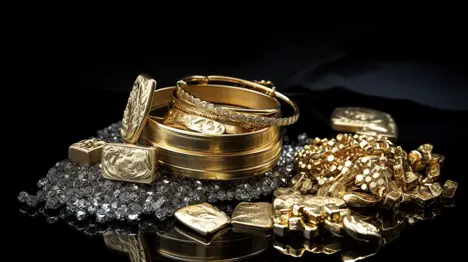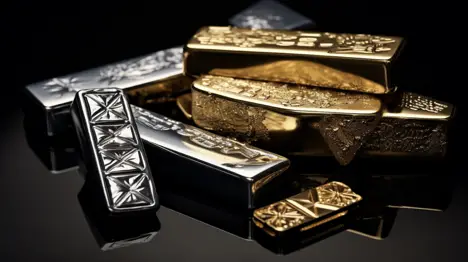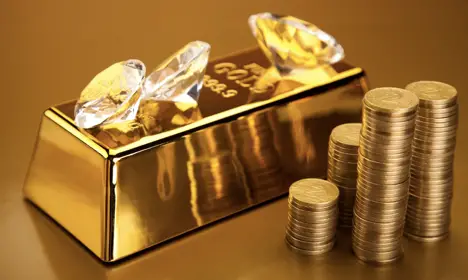Retirement accounts can now hold tangible assets like gold, silver, platinum, and palladium. They can be in the form of glittering and shiny bars and coins, and as long as they meet the purity and fineness requirements of the IRS, they are good to go.
Traditional IRAs are more heavily invested in stocks, bonds, mutual funds, and other paper assets, while going with the gold SDIRA can give you an option to diversify and invest in either tax-free or deferred accounts. See more about SDIRA on this page here.
Several benefits can be gained with these precious metals including the protection of your retirement savings, diversification of your portfolio, and hedge against inflation. This is because investors flock to “safer” investments like gold which have retained their value for centuries when there are economic downturns and geopolitical problems. Bullion has outperformed various company stocks during periods of high inflation, and it can also result in long-term growth, and this is why so many investors prefer them over the others.
Roles of Silver and Gold in Your Portfolio

Metals have chemically-unique structures that can last for a very long time. Gold is malleable, rare, and beautiful, and it’s been a symbol of wealth for many generations. You can historically store your money in bullion for the long term. Another thing is that precious metals can maintain their purchasing power over time, and this applies globally. Those countries that are facing a possible currency devaluation and inflation can benefit from them because they don’t mirror the price movements of paper assets and even real estate.
However, there are downsides that you need to consider too, because storing your gold coins and bars in a vault for long periods will mean that you don’t get dividends, cash flow, and interest from them. They are volatile, and mining companies with poor management can lose money over time.
On the other side are people who are not too trusting with their banks and governments. In some countries like Nigeria or Greece, they value these assets more rather than having cash because investors today can’t be too complacent. Even the banks need to be bailed out by the Federal Deposit Insurance Corporation because they are declaring bankruptcy left and right. See the post about bankruptcy at this link: https://www.econlib.org/library/Enc/Bankruptcy.html.
So, how much is enough when you hold precious metals? This will depend on where you’re currently residing, your age, your current financial situation, and your goals. It’s best to have at least 5% to 15% of your portfolio invested in more tangible assets so you can have a hedge against the economic uncertainties that can come unexpectedly. Don’t miss out on the passive income and dividends that you can get from bonds and stocks.
However, other investors are worried because you’re betting on something that you’re hoping someone else would pay for in about six months. The gold and silver bars themselves won’t do anything for you on their own, and it can be a different game when you’re buying something and put your fate in the hands of sellers, hoping you could get a good price with them.
Another thing is that there are several transaction costs that you need to pay when investing in precious metals. Dealers may melt these bars that they’ve acquired for wholesale prices, turn them into an investment-grade quality, and sell at the current retail price. You also need to pay for the shipping, storage, insurance, and security, and there’s always the risk of loss and theft. Having a reasonable physical bullion allocation is not bad, but you also need to know what you’re getting into before investing.
Ways on How You Can Get Started

1. Executing a ROTH IRA Rollover
Retirement accounts are a great way to protect yourself against market fluctuations and other uncertainties, and this generally provides investors with a more attractive option, especially if they are seeking stability.
Get in touch with a custodian or a precious metals brokerage that can help you open an SDIRA account and process the transfers and rollovers. Get more information at https://goldco.com/precious-metals-ira/gold-ira/ and see how this works. The company can provide you with resources and support every step of the way, and with its wide range of products, you’re not going to be running out of options.
Others will have a 401k rollover where you can transfer some of the funds from your previous employer, you can roll over some of these funds without penalties and additional taxes. Direct trustee-to-trustee processes can be the preferable option because you can rest assured that the funds are going to go directly to the newly opened account.
Going through the route of an indirect rollover will mean that you’ll have to withdraw the funds and deposit them into the precious metals retirement account within 60 days. Failure to do so can result in a 10% early withdrawal penalty, so you’ll have to be careful with this.
So, why should you go through the hassle of doing all of these? Well, it’s because gold has been a haven for investors against natural disasters, wars, and market fluctuations. Weather any storms and secure your wealth by creating a strategy that will significantly reduce the risks that you’re taking. Other methods are the following:
2. Options and ETFs
One of the easiest ways to dabble your way into precious metals is through exchange-traded funds. It’s going to be extremely liquid, and you can buy and sell at any point without worrying about extra fees. Before, the available ETFs can be considered expensive, but with the SPDR Gold Trust, which has an expense ratio of 0.40%, iShares Gold Trust, Sprott Physical, and Perth Mint, there are a lot of options where you can join the field and see how it goes.
Silver is also joining the trends, and the iShares versions came out in the early 2000s and were a bit cheaper than the GLD. In 2018, the SPDR has become the best bet in many markets. However, there are also the downsides that you need to consider, such as you’re not going to be able to redeem the ETF that you’re holding for physical silver and gold. There’s no guarantee that you’ll have an asset on hand after all the transactions, and when the market goes dark, you can say goodbye to the money that you’ve invested in.
One exception is the Perth Mint, where the funds are stored in a physically allocated bar and gold. This is the same sentiment with the Sprott collection, so they are considered to be safer. Savvy investors are in the market for option weaving while collecting the premiums for each sold put and call. This is where you buy low and sell high, but you’ll have to be a full-time trader in the market to be successful in this.
3. Royalties from Mining Companies
If you know any stable company, you can consider buying their stocks, especially if they are heavily invested in the metals. Streaming or royalty companies need upfront cash to develop the operations of a mine. Once it’s active and is producing a certain amount of bullion, everyone is going to get a cut out of the profit, and they will continually make investments for more profits.
These are the deals that are not too dependent on normal debts. When receiving money in exchange for a royalty deal, the companies are not stuck with the original amount that they’ve borrowed as they would have when they are in debt with their investors. Instead, the obligation is leaned or levered on the prices of the metals, so when gold goes up, they would have fewer debts instead. It’s less risky for them, and the returns can be higher.
Examples are Wheaton precious metals, Royal Gold, and Franco-Nevada which are the most established ones. Upcoming new companies are also an option, but when they are still younger and only a few years in operation, they tend to be riskier. More information about mining companies is on this webpage.
After covering the different ways to get precious metals, you might want to know other advantages of why you should get them. Unlike fiat money that can be printed by the banks at will, gold can’t be reproduced in any laboratory setting, and it does not corrode. It’s valuable in many industries because of its aesthetic looks, the ability to be a conductor of electricity, and its malleability.
Technological and industrial uses have grown over the years, and as the population explodes, the demand is expected to increase for this commodity. In theory, over the long term, there may come a point where the dollar should devalue against the bullion’s prices, and it has indeed happened during the pandemic and the recession.

